

Monday, September 9, 2002
![]()
Every morning we wake up with the tide higher than it was
the day before. Today was no exception. Normally the prevailing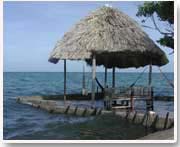 winds blow from the East but this morning they were blowing from the West
making the high tide even higher as waves crashed over the wall. While the
palapa is sturdy, it gave the illusion that it was listing towards the sea.
The morning transmission with the satellite phone was done standing in a
half foot of water.
winds blow from the East but this morning they were blowing from the West
making the high tide even higher as waves crashed over the wall. While the
palapa is sturdy, it gave the illusion that it was listing towards the sea.
The morning transmission with the satellite phone was done standing in a
half foot of water.
Cricket
 Cricket,
a local fisherman, came by with his son to sell lobsters to Caryn. When
Caryn and Katie are here, he often sells them fresh fish. Cricket is 52
and has been fishing these waters his entire life. He explained how he catches
lobster with a pole that has a sharp hook on the end. When the sea is calm,
he sometimes motors as far as Lighthouse Reef Atoll where we were Saturday.
We found this amazing as his boat looked like it would barely stay upright.
Cricket,
a local fisherman, came by with his son to sell lobsters to Caryn. When
Caryn and Katie are here, he often sells them fresh fish. Cricket is 52
and has been fishing these waters his entire life. He explained how he catches
lobster with a pole that has a sharp hook on the end. When the sea is calm,
he sometimes motors as far as Lighthouse Reef Atoll where we were Saturday.
We found this amazing as his boat looked like it would barely stay upright.
Cricket is an expert free diver and he explained how he does
not use a strap on his mask, keeping it in place by balancing his breath
and the pressure. He can free dive down to 60 feet with ease. Later in the
day Cricket came back with a Hogfish. As we chatted, he scaled and filleted
it for us. We feasted on both the delicious fish and the lobsters for dinner.
Heusner’s Bogue
On Friday, we started our manatee work with a survey at the mouth of Heusner’s
Bogue. Shortly after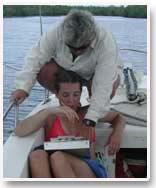 starting, someone spotted a manatee half way out of the water among the
mangrove roots. For a moment we thought it might be dead but it swam underwater
when we stopped the boat. Caryn had Gilroy move the boat back to the mouth
of the bogue and she jumped in with her underwater camera. Intuition told
her that the manatee would try to swim out of the bogue and to do so, it
would have to swim right by her. She was right. Her good instincts were
rewarded with some very excellent underwater footage.
starting, someone spotted a manatee half way out of the water among the
mangrove roots. For a moment we thought it might be dead but it swam underwater
when we stopped the boat. Caryn had Gilroy move the boat back to the mouth
of the bogue and she jumped in with her underwater camera. Intuition told
her that the manatee would try to swim out of the bogue and to do so, it
would have to swim right by her. She was right. Her good instincts were
rewarded with some very excellent underwater footage.
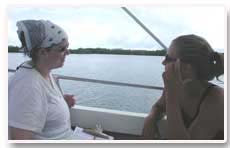 Looking
for manatees can be tedious and the days can be very long as we travel to
the different scan points and wait for manatees to appear. For every exciting
encounter, there are hours when no manatees are observed. In between sightings
we cool off in the water, converse with one another, watch for other wildlife,
and even catch a nap or two. This down time provides us with an opportunity
to take a closer look at the detail of what surrounds us here; whether it
be the Osprey eagle flying overhead or jellyfish floating in the water.
There is so much life here we can't possibly become bored. And of course,
when we aren’t in the midst of a sighting, Caryn works with us to complete
the data sheets correctly.
Looking
for manatees can be tedious and the days can be very long as we travel to
the different scan points and wait for manatees to appear. For every exciting
encounter, there are hours when no manatees are observed. In between sightings
we cool off in the water, converse with one another, watch for other wildlife,
and even catch a nap or two. This down time provides us with an opportunity
to take a closer look at the detail of what surrounds us here; whether it
be the Osprey eagle flying overhead or jellyfish floating in the water.
There is so much life here we can't possibly become bored. And of course,
when we aren’t in the midst of a sighting, Caryn works with us to complete
the data sheets correctly.
Social Behavior
Late Friday afternoon we rounded the corner of a mangrove and came upon
what looked like two manatees engaged in social behavior. For Katie and
Caryn, this is defined as two or more manatees in physical contact with
one another. They have observed social behavior often in the field as manatees
appear to be very tactile animals. Manatees like to rub up against each
other and against other objects.
 From
the boat we observed the manatees rolling and diving in very close contact
with one another. Gilroy, Tami, and Caryn watched from the bow of the boat
to get a better idea of what was going on. At one point, one manatee rolled
over onto its back and patted its chest with its flippers. Caryn has only
observed this behavior among manatees in aquariums. The animals were also
“mouthing” each other. This is when one manatee touches the other
with its mouth.
From
the boat we observed the manatees rolling and diving in very close contact
with one another. Gilroy, Tami, and Caryn watched from the bow of the boat
to get a better idea of what was going on. At one point, one manatee rolled
over onto its back and patted its chest with its flippers. Caryn has only
observed this behavior among manatees in aquariums. The animals were also
“mouthing” each other. This is when one manatee touches the other
with its mouth.
We set the anchor pole and Caryn jumped in the water with her camera. Rather
than use a traditional anchor in these shallow muddy channels, Gilroy pushes
a long pole into the mud and ties the boat to it. Caryn was able to follow
the manatees for close to an hour. Gilroy stood sentry at the back of the
boat and directed Caryn to the location of the manatees as they swam about.
Krisan was logging their behavior in two minute intervals as Tami called
to her what she was observing.
When manatees are engaged in social behavior they are not
as skittish as when they are alone. At these times, Caryn can often get
quite close to them in the water. The problem is that their behavior stirs
up a lot of mud, making it difficult for her to film them.
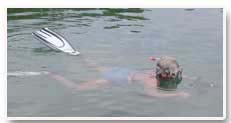 Back
on boat, she described what she had experienced in the water. When she first
got in the water she said she could only see clouds of mud and couldn’t
see the manatees. Suddenly, they appeared directly beneath her. They were
still in contact
Back
on boat, she described what she had experienced in the water. When she first
got in the water she said she could only see clouds of mud and couldn’t
see the manatees. Suddenly, they appeared directly beneath her. They were
still in contact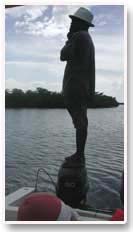 with one another and appeared to be oblivious to her presence. One manatee
actually bumped into the camera lens.
with one another and appeared to be oblivious to her presence. One manatee
actually bumped into the camera lens.
Caryn discovered that there were actually three animals present
once she was in the water. One was definitely a female because she had teats
located under her forearm. The second manatee was smaller and Caryn could
not identify its sex. The third manatee was much larger with a large abdomen
suggesting that it might be a pregnant female. This one swam away and stayed
at a distance while the other two continued with their behavior close to
Caryn.
Soon, the manatees became aware of Caryn and the first female swam closer
to investigate her. At one point this animal looked directly into the camera
from about a foot away. The other, smaller animal was more interested in
the female and wasn’t paying much attention to Caryn. It kept rubbing
up against the female. The manatees kept popping up all around Caryn as
she tried to film them. Eventually, however, they swam away and Caryn returned
to the boat.
It is difficult for Caryn to interpret the behavior she was seeing. It was
possible that if the smaller manatee was a male, perhaps it was engaging
in behavior that it would need one day to reproduce successfully—it
was practicing, so to speak. Florida researchers, who have been observing
manatees for a long time, have described such social behavior. Nobody knows
for certain, however, if manatees form long-term social bonds. One researcher
has reported resightings in Florida of the same animals together. It will
take much more time before Caryn can determine if the manatees she is observing
form social bonds.
Sultan
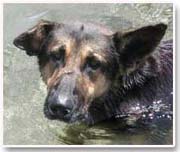 Sultan,
the dog, has had an ear infection ever since we arrived. In fact, Hannah
said he has had it most of the summer. His ear is swollen to the point where
it won’t stand up like his other ear, making him appear inquisitive
all the time. We decided collectively that we should try to treat him since
there is little chance he will get medical attention. A number of people
brought Cipro, a general antibiotic, just in case they got ill while here.
We figured we could give some to Sultan. First, we needed to know if it
was safe to give a dog the drug and how much we should give him. We needed
the advise of a veterinarian. We called Ernest in the United States since
his brother is enrolled in veterinarian school. He was able to make a quick
call to his brother and then call us with the necessary information. We
are now treating Sultan and his ear is actually looking better.
Sultan,
the dog, has had an ear infection ever since we arrived. In fact, Hannah
said he has had it most of the summer. His ear is swollen to the point where
it won’t stand up like his other ear, making him appear inquisitive
all the time. We decided collectively that we should try to treat him since
there is little chance he will get medical attention. A number of people
brought Cipro, a general antibiotic, just in case they got ill while here.
We figured we could give some to Sultan. First, we needed to know if it
was safe to give a dog the drug and how much we should give him. We needed
the advise of a veterinarian. We called Ernest in the United States since
his brother is enrolled in veterinarian school. He was able to make a quick
call to his brother and then call us with the necessary information. We
are now treating Sultan and his ear is actually looking better.
Manatee Scars
We listened to a talk given by Tami about the manatee photo identification
project that  she
was a part of in Florida. It was interesting, but also depressing. Ironically,
the primary way that researchers are able to identify individual manatees
is by photographing their scars—many of which are mutilations from
encounters with boats. Tami showed us a number of photographs of scarred
manatees. Caryn had video of a manatee here that is missing most of its
paddle. It is amazing that these animals can withstand such wounds and survive.
she
was a part of in Florida. It was interesting, but also depressing. Ironically,
the primary way that researchers are able to identify individual manatees
is by photographing their scars—many of which are mutilations from
encounters with boats. Tami showed us a number of photographs of scarred
manatees. Caryn had video of a manatee here that is missing most of its
paddle. It is amazing that these animals can withstand such wounds and survive.
FYI: Team member "X", who will still remain unnamed but who listens to her CDs every night before sleeping—has reached her goal of 14 days without a shower! Way to go!
A Dolphin and A Manatee
Today is our last day on the caye. Tomorrow morning early, Mario
will pick us up and take us back to Belize City. From there  some
of us will head to Caye Caulker for a few days and others will fly home
directly. Caye Caulker is a small resort town on another caye about 20 miles
northeast of Belize City. Caryn, Tami, and Hannah are staying until the
end of the week to pack up the research station for the season. Caryn will
not be returning to Belize until February 2003.
some
of us will head to Caye Caulker for a few days and others will fly home
directly. Caye Caulker is a small resort town on another caye about 20 miles
northeast of Belize City. Caryn, Tami, and Hannah are staying until the
end of the week to pack up the research station for the season. Caryn will
not be returning to Belize until February 2003.
Caryn wanted one last day to observe manatees, so today we all went out on the boat. We traveled up Bogue F into a back lagoon area that Caryn had not visited much this season. Every other time she had always seen manatees there. This time we didn't see any, but the area was still beautiful to observe.
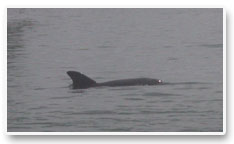 To
get there we had to temporarily collapse the sun canopy and carefully motor
through a very tight mangrove channel. At times we were literally pulling
the boat along by holding onto the dense mangrove branches we were passing
through. It is easy to imagine how the buccaneers could have hidden from
the authorities in these back lagoons in times past. It is also easy to
imagine getting lost. It is only the last few days that we have begun to
get a sense of where we are in relation to the research station and Belize
City when we are out looking for manatees.
To
get there we had to temporarily collapse the sun canopy and carefully motor
through a very tight mangrove channel. At times we were literally pulling
the boat along by holding onto the dense mangrove branches we were passing
through. It is easy to imagine how the buccaneers could have hidden from
the authorities in these back lagoons in times past. It is also easy to
imagine getting lost. It is only the last few days that we have begun to
get a sense of where we are in relation to the research station and Belize
City when we are out looking for manatees.
After our unsuccessful scan we motored/pulled our way back
out of the overgrown channel. When we were stopped for lunch we spotted
a manatee. We took note of it and continued with our lunch. After lunch
and a swim, someone spotted a dolphin. Within seconds, everyone realized
that the dolphin was swimming alongside a manatee. They were swimming together!
Although dolphins have been observed with manatees, this is unusual behavior.
We were able to follow this pair for over an hour as they swam together.
The dolphin was even taking breaths the same time as the manatee. At one
point the dolphin made a spectacular double leap clear out of 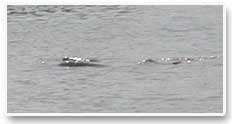 the
water. Eventually we lost track of the manatee and the dolphin headed out
to deeper water. It was an absolutely amazing experience for all of us and
a perfect ending to our expedition.
the
water. Eventually we lost track of the manatee and the dolphin headed out
to deeper water. It was an absolutely amazing experience for all of us and
a perfect ending to our expedition.
We returned home early so that we could pack for tomorrow morning's departure.
Our time has gone quickly but we have seen and learned so much. Caryn and
Katie have been wonderful to work with and ever so patient with us. We could
not imagine being here without Gilroy and Hannah—they both worked hard
to make our stay here comfortable. The team has been wonderfully cooperative
and cohesive. Even though we are looking forward to going home, it will
be difficult to say good-bye.
We will be posting our final thoughts about our time here later this week. Krisan's final journal entry is already posted!